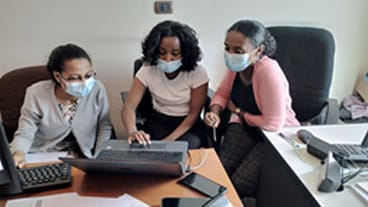At a glance
This story emphasizes the impact of TB in Ethiopia and the challenges that PLHIV encounter in accessing treatment. With CDC's support, health facilities have the means to prioritize TB preventive treatment (TPT) uptake and help end the dual epidemics of HIV and TB.

Background
Mycobacterium tuberculosis (TB), which causes TB disease, infects about a quarter of the world's population. Although it is curable and treatable, over 10 million people develop TB around the world each year.
The risk of developing TB is higher for people with a compromised immune system. For example, people living with HIV (PLHIV) have up to a 20 times higher risk of TB than those without HIV. TB is one of the most common life-threatening infections and a leading cause of death among PLHIV. Through support from the U.S. President's Emergency Plan for AIDS Relief (PEPFAR), CDC is on the front lines to bring an end to these dual epidemics.
For PLHIV, effective screening and tuberculosis preventive treatment (TPT) can prevent TB infection. TPT is a proven course of treatment that can prevent TB disease among those infected with TB. The treatment has been shown to reduce TB-related mortality among people living with HIV by 37 percent. Coupled with antiretroviral treatment (ART), TPT can lower the risk of TB disease and help PLHIV live longer, healthier lives.
Addressing barriers to TB treatment
Many lack support for the TB treatment they need. This is especially true for those most vulnerable to TB, including children, PLHIV, and healthcare workers. Furthermore, stigma, discrimination, and other barriers exist that prevent access to TPT. Improving TPT uptake requires close investigation of these factors and innovative solutions to overcome these barriers. CDC Ethiopia partnered with regional health bureaus (RHB) to identify 15 health facilities serving over 1,000 PLHIV with under 70% TPT coverage.
RHB partners provided intense site-level support and mentorship. These interactions were often required to shift to virtual interactions due to the COVID-19 pandemic. CDC Ethiopia also provided six months of support from April to September 2021 to help implement quality improvement approaches. These approaches focused on improving TPT uptake and completion among those served at the health facilities.
CDC's impact
RHB implementing partners managed the targeted TPT intervention in their respective regions. RHB focal persons also conducted regular performance monitoring with CDC and CDC implementation partner, ICAP to monitor the initiative's impact. In April 2021, only 60% of PLHIV received TPT at the 15 sites. By the end of the initiative in September 2021, this increased to 74%. Within six months, CDC Ethiopia's innovative program provided lifesaving TPT to an additional 7,931 PLHIV who were on ART.
Several features of CDC Ethiopia's support were effective in improving program performance. These included:
Cost-effectiveness
Prioritizing high client load facilities with low TPT coverage as a cost-effective approach helped achieve maximum impact with minimal investment. This was accomplished by addressing the massive backlog of TPT coverage at these few facilities.
Monthly progress meetings
Monthly virtual progress meetings organized by CDC's Division of Global HIV and TB were instrumental in identifying program successes and challenges. During the calls, CDC also provided technical assistance, shared best practices amongst health facilities, and identified challenges for performance improvement planning.
Electronic medical records
Electronic medical record data was instrumental for close monitoring of program progress in near real-time. The data also provided timely support for course corrections.
Looking towards the future
CDC and partners intend to expand these interventions to additional health facilities with significant TPT coverage gaps to maximize program impact.
